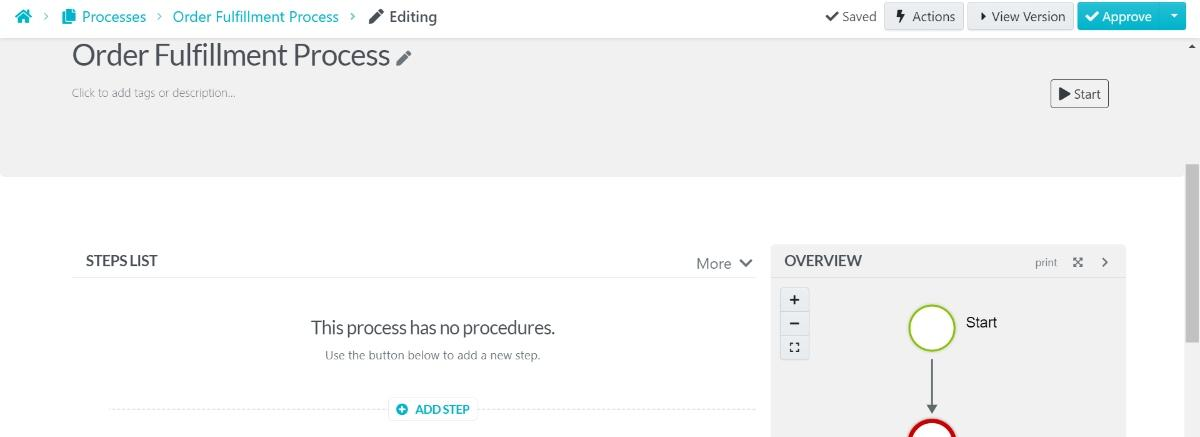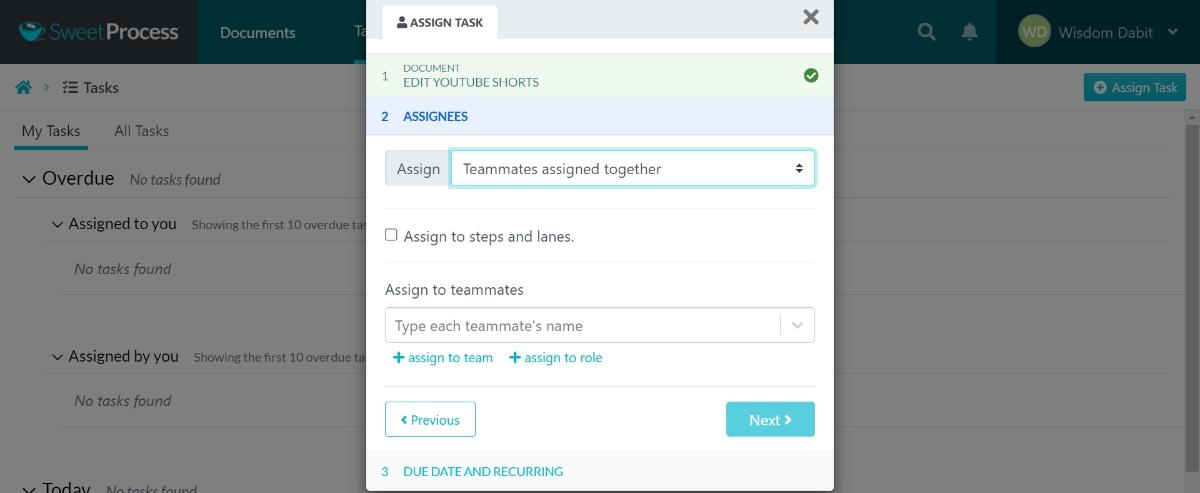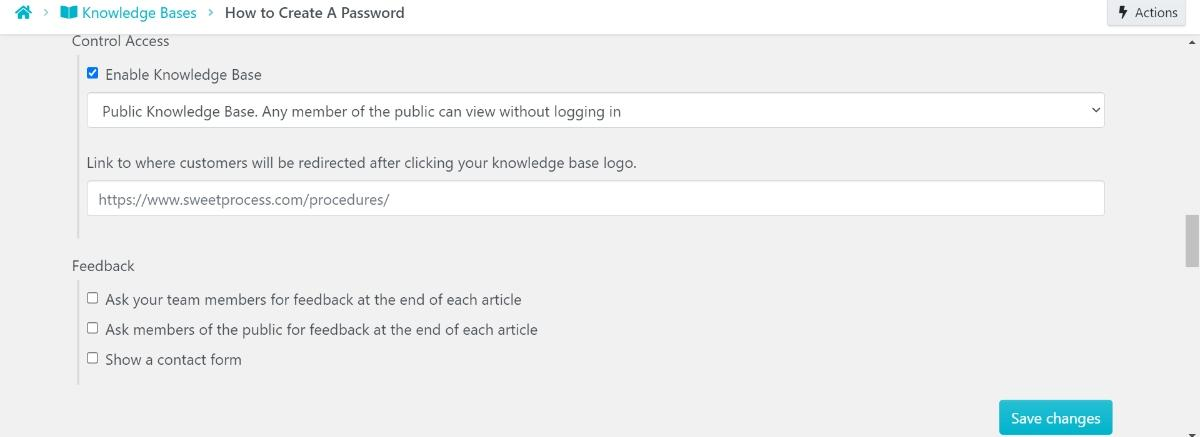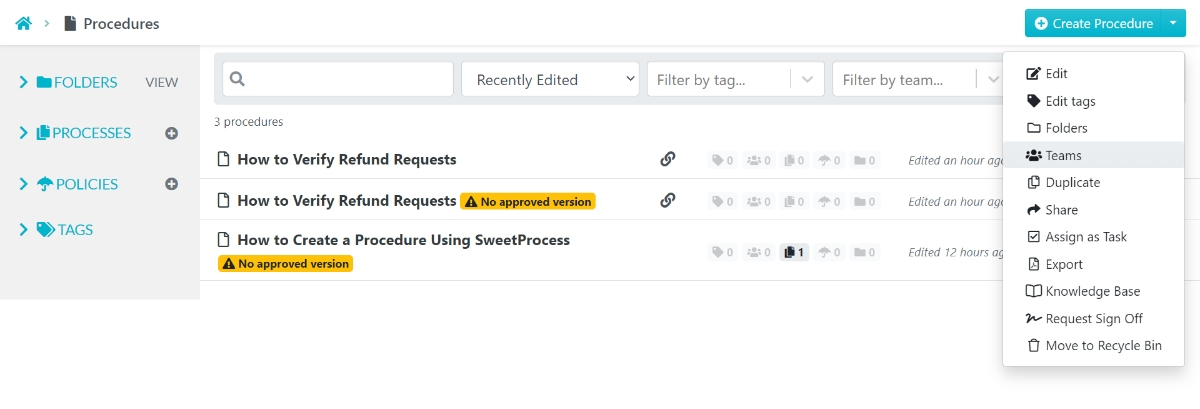Last Updated on March 2, 2025 by Owen McGab Enaohwo

Improving employee engagement and maximizing profits depends on how good a manager is. Companies always thrive in workplaces where employees love their jobs and customers feel more satisfied.
According to a Gartner report, employees who work under effective managers are 15 times more likely to excel and three times more likely to stay. Likewise, a Gallup study shows that a great manager can achieve 48% higher profitability, 22% greater productivity, and 30% better employee engagement scores.
But let’s face it: Being a successful manager is tough, but when managers get it right, employees feel motivated, customers are happy, and profits soar.
In this post, we’ll share insights and tips from managers who know how to lead high-performing teams. This will help you become a better manager and inspire your team to be more efficient.
Want to improve your team management skills? Sign up for a free trial of SweetProcess today and see how it can simplify your team’s management. The best part? You can test-run it for up to 14 days without providing credit card information.
TABLE OF CONTENTS
13 Must-Have Qualities of a Good Manager
How to Manage Your Team Effectively and Seamlessly With SweetProcess
9 Tips to Help You Succeed as a Manager in the Workplace
Examples of Good Managers You Can Learn From
Take Your Team Management Skill to the Next Level Using SweetProcess
13 Must-Have Qualities of a Good Manager

If you’re interested in how to be a good manager, you can apply some of the qualities below to build a productive work environment that fosters growth, innovation, and success.
1. Focus on Employees Strength
Great managers understand everyone has unique talents and abilities. They focus on helping team members find and leverage their strengths to achieve goals. This boosts employee retention and confidence and reduces employee turnover, as they feel more valuable and motivated to contribute and boost the overall team output.
2. Help Employees Career Development
To build an effective and dedicated team, show your employees you are concerned about their professional aspirations and career goals. Give them access to refresher courses, learning, and leadership training materials when necessary so they can get up to speed with your company’s operations and become top performers.
This assures them that you’re not intimidated by their success. Hence, they feel more motivated to work harder and improve organizational effectiveness.
3. Be Confident and Assertive
A good manager exhibits confidence and assertiveness, which ensures your ideas, suggestions, and instructions are respected. However, knowing when taking charge or being decisive crosses the line or becomes arrogant is important, as that might put off some teammates.
4. Create a Positive and Inclusive Workplace
Aside from being inclusive, a positive work environment encourages productivity, makes everyone feel valuable, recognizes individual efforts, and rewards them to boost morale.
5. Communicate Goals, Expectations, and Feedback
Effective communication is important for developing a good management style. Clearly defined goals and expectations keep everyone on the same page. A good leader doesn’t leave this to chance. They set specific goals and expectations while listening to employee concerns and giving ongoing feedback to help employees know their strengths and lapses for improvement.
6. Practice Active Listening
Active listening is not about merely hearing what someone says. A great leader pays careful attention, asks questions, and understands the speaker’s point of view to give their team members the impression that they value their input and foster team engagement.
7. Know When to Push (and When to Stop)
Another exceptional quality of a good manager is learning how to motivate team members to crush huge business targets when necessary. However, they find balance by considering individual differences to avoid causing their teammates to burn out.
8. Be Open to New Ideas
Good ideas can come from anywhere. A good manager promotes creative ideas and innovation. They will try out new ideas and suggestions from their teammates and encourage a culture of experimentation and learning, which helps the team adapt to industry change.
9. Be Inclusive
One of the best traits of a good manager is valuing diversity in the workplace and promoting inclusivity.
They ensure that all team members feel respected and included in decision-making processes. This leads to having an engaged and high-performing team.
10. Empower and Coach Your Team Members
Effective leaders give their team members the permission and resources to decide and take ownership of their work. Coaching also helps them hone their operational and leadership skill, improving overall business administration.
11. Hold Yourself Accountable
Good managers take pride in accepting responsibility when heading their teams. Taking responsibility for your actions and the team’s outcomes helps to build trust. It also sets a good example and encourages the team to be accountable.
12. Do Not Micromanage
Micromanaging usually involves a team leader hovering around their employees and seeking to control everything they do. This stifles their creativity and reduces motivation. A bad manager overbear to that extent. They don’t give guidance when necessary.
13. Recognize and Reward Good Work
To be a good manager, acknowledge and reward your team members’ work. This appreciation helps boost employees’ productivity. Doing this consistently shows that your team members’ hard work is valued and appreciated.
How to Manage Your Team Effectively and Seamlessly With SweetProcess

SweetProcess is a handy tool for team and task management. It can record recurring tasks, create a knowledge base, create and assign tasks, and set up teams.
Document Repetitive Tasks in One Place
To do this, click the “Processes” tab and the “Create Process” button.
Enter a name and a description for your process.

Then go to “Click to add tags or description” and click the “Add Step” button to convert it to a step (if you want).

Then, depending on your business, click “ADD STEP” to add each specific step they must take to complete the recurring task.
Turn Procedures and Processes Into Actionable Tasks
Go to the “Tasks” section in SweetProcess and click “Assign Task.”
Choose from your existing procedures or processes. Then click on “Next.”

Select the assignees or teammates you want to handle the task and set due dates for tracking completion.

Turn Existing Procedures and Policies Into a Beautiful Knowledge Base
You can use SweetProcess to create a knowledge base that allows your customers, teammates, or suppliers access to your procedures and policies in a beautiful knowledge base.
To do this, click “More,” then select “Knowledge Bases.” Give it a title, and click on “Continue.”

Then, select your preferred theme from the range of beautiful options displayed.

Determine how accessible it can be. You can check whether team members or members of the public can give feedback, or you want the knowledge base to display a contact form and save changes.

Again, to make it even more beautiful and personalized, you can customize the text blocks to suit your brand voice and information needs by editing the contact form message label, page heading, subject labels, sidebar category heading, index page, and breadcrumb home text.

Likewise, you can customize the knowledge base URL to match your brand style.

Manage Procedures, Processes, and Policies
Once you’ve saved your policy, procedure, or process document in SweetProcess, you can manage your processes by following these steps:
To edit, share, duplicate, export, or even send a document to the recycle bin, click on the three dots beside the process and select the action you want to accomplish.

Set up Teams to Reflect Your Company Culture
Here are the steps to set up teams in SweetProcess to mirror your company structure:
Know all the departments or teams in your company, such as marketing, sales, or engineering.
From your dashboard, go to the “Teams” segment and click “Create Teams,’’ then enter the team’s name and write a befitting description. Click on “Create Team.”

Then, specify the role they are to carry out or give it a title, then click “Confirm.”

Select or add a member or members to the team and click on “Confirm” to save changes.

You can sign up for a 14-day free trial of SweetProcess to see how it can help you manage your team. The best part? You’re free to try it for up to 14 days. No credit card is required.
9 Tips to Help You Succeed as a Manager in the Workplace

Succeeding as a manager requires a mix of experience, skills, and Continuous Quality Improvement (CQI) in leadership. Whether you’re new to management or refining your approach, here are nine essential tips:
1. Set Clear Goals and Deliverables
Clearly define what you expect from everyone on your team and ensure they understand the grand plan. This roadmap will help everyone understand what’s required of them, stay focused on seeing it happen, and stay on the right track.
2. Invest in an Effective Management Skill Training Program
Honing your management skills through training and self-help programs will help you stay updated with the best strategies to improve your leadership qualities. These programs can equip you in role delegation, resource allocation, communication, and conflict resolution.
3. Set up Regular Check-Ins
Set regular checkups to stay connected with your team. You can make it weekly, have one-on-one meetings, or occasionally. These check-ins allow you to discuss progress, address issues or challenges, and get feedback.
4. Give and Receive Feedback
It’s essential to provide constructive feedback to help your team members. Also, be open to receiving feedback. It’s essential for both self and organizational development.
5. Lead by Example
Show, don’t tell. Illustrate the behaviors and work ethic you expect from your team members, whether it’s your attitude, work ethic, or commitment to excellence.
6. Evaluate Your Management Style
There’s no one-size-fits-all style to management. Be willing to reflect on your approach as you adapt it to changing situations and team dynamics where necessary.
7. Delegate Tasks to the Right Team Members
Identify the strengths and weaknesses of your team members and delegate tasks accordingly. This will empower your team members and free up your time to focus on what moves the needle.
8. Make decisions
A good manager is decisive. Be prepared to make tough calls when necessary. However, weighing your options and making informed decisions that benefit the team and organization is also important.
9. Be Honest
Honesty and transparency are essential for building trust with your team. Be honest with your team about challenges, goals, and expectations. Build trust with your team members by being approachable and sincere.
Good managers read good books. Explore great ideas from these best books on leadership and management.
Examples of Good Managers You Can Learn From

We interviewed three professionals on their experiences with outstanding managers, and here’s what they had to say.
According to Riva Jeane May Caburog’s experience as PR/media coordinator at Nadrich & Cohen personal injury law firm, she shared: “My previous manager stood out because he believed in accountability from the top down. When things didn’t go as expected, he didn’t play the blame game. Instead, he took responsibility, even when it meant facing tough questions from higher-ups. This created a culture of trust and honesty within our team. We felt supported and encouraged to own our actions and learn from failures. It wasn’t about pointing fingers but about learning and growing together. That greatly impacted how we worked and achieved our goals.”
Jonathan Feniak, the general counsel and head of finance at LLC Attorney, added: “At my current company, LLC Attorney, one individual exemplifies excellent managerial skills: our CEO. The one specific trait that makes our CEO stand out is his proactive communication skills. Without fail, he ensures that each team member understands the company’s goals, their role in achieving them, and everyone else’s contributions. This approach resulted in a more cohesive team and motivated us to strive for collective success.”
Gabriel Lukov, head of inbound growth at Business Map, agrees that collaboration is key. “What makes our CEO stand out in her managerial role is her application of agile principles beyond the development teams, ensuring these principles permeate every facet of our organizational culture. One of her standout attributes is her retrospective meetings at the end of every project management task. These meetings allow every team member to openly share what worked well, what didn’t, and how we can improve. Her open-mindedness, readiness to adapt, and commitment to continuous improvement make her an outstanding manager.”
As these insights highlight, fostering teamwork and collaboration is essential for managers. Tools like team communication software can help everyone get on the same page to enhance efficiency. That’s why you need a team, or at least task management software, to manage everything and save time.
Take Your Team Management Skill to the Next Level Using SweetProcess

Every company needs an effective manager to lead its team to success. Following the tips above, you can develop the skills and strategies to lead your team to crush bigger goals.
However, managing a team effectively can be complicated. There are just too many moving parts to keep track of, from mapping out goals and assigning tasks to supervising each employee, providing feedback, and ensuring they’re all on the right track to hitting KPIs (key points of interest).
This is where SweetProcess can help. SweetProcess is a tool built with managers in mind to simplify team management. With It, you can easily create and share standard operating procedures (SOPs), onboard new hires, assign roles, track projects, and give feedback from a single dashboard.
SweetProcess can help you save time, boost efficiency, and ensure your team always works toward your overall business goals.
Want to improve your team management skills? Sign up for a free trial of SweetProcess today and see how it can transform your team management. You can test-run it for up to 14 days without adding your credit card information.
